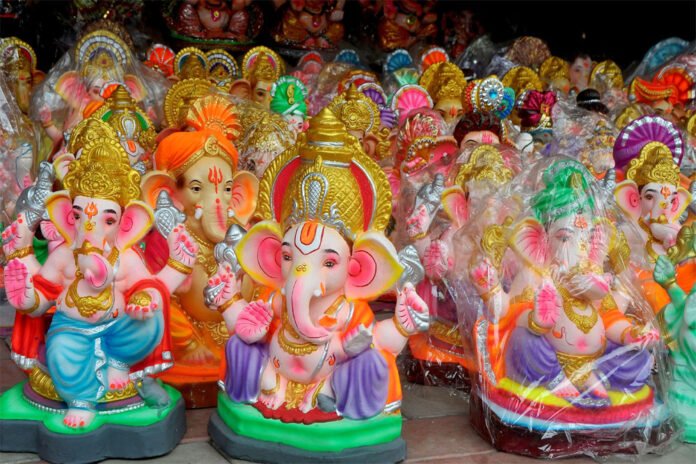In India, Ganesh Utsav is celebrated from Chaturthi to Chaturdashi of Bhadrapad month. It is a mythological festival of Hinduism which lasts for ten days. Ganesh Utsav has been organised for ages. We can find evidence of the festival in the Satavahanas.Ganesh Utsav is found from the period of Rashtrakuta and Chalukya dynasty. Maratha ruler Chhatrapati Shivaji Maharaj started a new initiative by linking it with national religion and culture.
Shri Ganesh Ji is the first worshipped deity in the Sanatan tradition. There are different traditions of Ganesh Utsav in North India, South India, East and West India but in all the traditions, Ganesh Ji’s place is very revered and respected. In these traditions, the ten-day festival tradition that started in Pune, Maharashtra is celebrated with great enthusiasm and gaiety not only in the whole of India but also in many countries of the world. When will Ganesh Chaturthi be celebrated? How will it be celebrated? How will the Puja be performed, everyone knows about this but you probably don’t know that Ganesh Ji has also been associated with Section 144 of the law. How is it related, what is the connection? Let us tell you.
After the revolution of 1857, the British, in panic, implemented a very big law in 1894, which is currently called Section 144. In the new law, it has been changed once again but people know it in this form. After the British government implemented this section of harsh law, no more than five Indians could gather at any place. In simple words, public events were prohibited. If any British officer saw them gathering, they were given such a severe punishment that it would send shivers down the spine. They were beaten with a whip and their nails were pulled out from their hands.
Due to this strict law of the British rule, fear had spread among the enslaved Indians. To end the fear of the British among the people and to oppose this law, Lokmanya Bal Gangadhar Tilak started celebrating Ganesh Utsav publicly. It started by celebrating Ganesh Utsav on a large scale in Shaniwarwada, Pune. Before 1894, people used to celebrate Ganesh Utsav at home. Even today, thousands of people gather in Shaniwarwada, Pune.
Tilak Ji had warned the British that the British police should arrest him. Because according to the law, the British police could only put in jail the crowd gathered in a political function, not the crowd gathered in a religious function. After the initiative started by Tilak Ji, Ganpati festival was celebrated for 10 days from 20 to 30 October 1894 in Shaniwarwada, Pune. Every day Lokmanya Tilak used to invite some big revolutionary to give a speech to the Indians.
On the 20th, Bengal’s biggest leader Vipin Chandra Pal and on the 21st, North India’s Lala Lajpat Rai reached there. Similarly, Chapekar brothers also reached there. These great leaders used to give speeches there for 10 days. The main basis of all the speeches was that we should free India from the British. May Ganapati give us so much strength that we can bring independence.
In the second year, i.e. in 1895, 11 Ganapatis were installed in Pune. Similarly, the number increased to 31 next year and the next year it crossed 100, after which the Ganesh Utsav program took the form of stage and pandals. Slowly, the Ganapati festival spread to big cities near Pune like Ahmednagar, Mumbai, Nagpur etc. A crowd of lakhs of people gathered on every Ganapati festival. The leaders invited to the festival worked to awaken the feeling of patriotism in them.
This type of effort was successful and the feeling of patriotism started increasing in the minds of people. This effort played an important role in uniting people in the freedom movement. In 1904, Lokmanya Tilak ji had told people in his speeches that the main objective of Ganpati Utsav is to achieve independence, to achieve Swaraj, to drive the British out of the country. There is no justification for Ganpati Utsav without Swaraj.
In India, Ganesh Utsav is celebrated from Chaturthi to Chaturdashi of Bhadrapad month. It is a mythological festival of Hinduism which lasts for ten days. Ganesh Utsav has been organized for ages. We find evidence of the festival from the period of Satvahan, Rashtrakuta and Chalukya dynasty. Maratha ruler Chhatrapati Shivaji Maharaj gave a new beginning to Ganesh Utsav by linking it with national religion and culture. This sequence of celebration has been continued since the era of Maratha rulers, after which the Peshwa dynasty started celebrating Ganesh Utsav on a large scale.
Since Ganeshji was the family deity of the Peshwas, Ganeshji was given the status of national deity at this time. After the Peshwa descendants, during the British rule till 1892, Ganesh Utsav was limited to Hindu homes only. According to the Constitution, India is a republic and the name of the deity who is worshipped as a symbol of the Gan i.e. the people is Ganapati, Ganesh. Along with traditional beliefs, it can also be said that our Ganpati Maharaj ji also played an important role in driving away the British and achieving Swaraj of India. (The author is the National President of Vishwa Bhojpuri Sammelan Sanstha and former Vice President of Maithili Bhojpuri Academy Delhi.)

